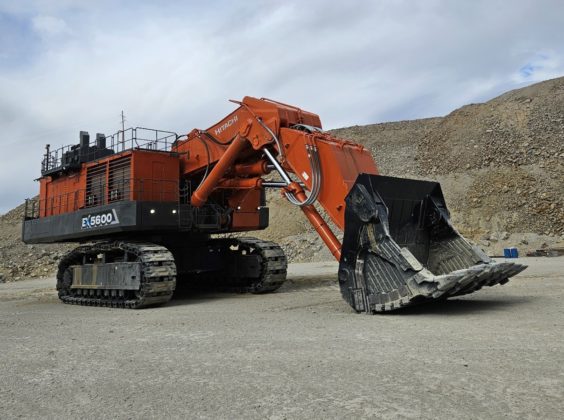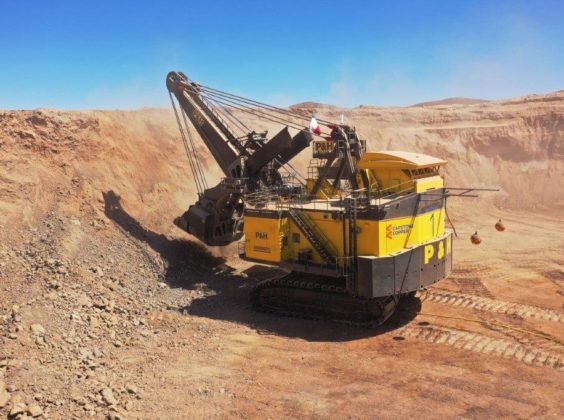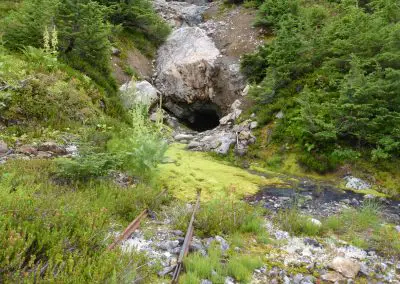The commissioning of the Mantoverde Development Project (MVDP) in Chile last year has propelled Capstone Copper up the mining rankings, yet, according to CEO John MacKenzie, this project is but a fraction of the potential within the company’s portfolio.
IM has been following the Capstone story for some time; covering new additions to the Pinto Valley and Mantoverde fleets in Arizona and Chile, respectively, reporting on the dry stack tailings developments at Cozamin (Mexico), noting down the results from testing out Eriez’s HydroFloat coarse particle flotation technology, and more.
In Riyadh, Saudi Arabia, on the sidelines of the Future Minerals Forum, IM sat down with MacKenzie to understand the big picture philosophy governing some of these moves and the company’s appetite for incorporating new technology.
The operations on the company’s books are all very different – most of these differences tied to the fact it was two companies that formed the current Capstone Copper: Mantos Copper and Capstone Mining. These two companies merged in 2022, bringing four operating mines and one development asset into the enlarged group.
Mantoverde, previously owned by Anglo American, is comprised of four open pits. The operation includes a copper concentrator to process sulphide ore, which started up in June 2024, and heap and dump (run-of-mine (ROM)) leaching with solvent extraction and electrowinning (SX-EW) to treat oxide ore for cathode production. It is in the province of Chañaral in the Atacama Region of Chile.
Mantos Blancos has been operating since 1960 and is in the Antofagasta region. Since 2020, as a result of depletion of the oxide reserves, processing in the oxide plant substantially decreased and only ROM dump leaching of low-grade ore was processed. The Mantos Blancos Concentrator Debottlenecking Development Project (MBCDP) was completed in late 2021 to extend the mine’s life and expand sulphide ore treatment capacity.
Pinto Valley is an open-pit mine within the Globe-Miami mining district of Arizona. It has been in operation since 1972 and, in October 2013, was acquired by Capstone Mining. The operation consists of an open-pit mine, a 60,000 t/d concentrator plant and a 11,400 t/y SX-EW plant.
Cozamin is an underground operation that commenced commercial production in 2006 at a rate of 1,000 t/d (current plant capacity is 3,780 t/d). The mine plan at Cozamin is based on a combination of longhole stoping and cut-and-fill mining methods.
The company also has a major development project on its books: Santo Domingo, which, if combined with Mantoverde, could unlock the potential to produce over 200,000 t/y of low-cost copper production with the option to also develop a battery-grade cobalt production stream for the company.
Optimise, debottleneck, replicate
Speaking to MacKenzie and scrolling through the latest investor presentation deck, it’s clear that, Santo Domingo aside, the focus at Capstone, close to three years on from the merger, is on refining the existing assets within the portfolio. This philosophy looks to be a rational way of furthering the business and ensuring it does not develop deposits beyond their long-life means on the way to hitting the 400,000 t/y status it is aiming for.

At Mantoverde, the largest operating asset by output, the focus has shifted from MVDP and is now moving to MV-O, or Mantoverde Optimised.
“When we built and commissioned MVDP, we deliberately oversized the major processing equipment, so instead of only being able to process 32,000 t/d of sulphides, it can deal with up to 45,000 t/d,” MacKenzie told IM.
The MV-O project envisages bringing the minor equipment and ancillary operations such as pumps and pipelines up to this same 45,000 t/d. Additional mining equipment will also be required to reach such a throughput rate.
Coming with a capital expenditure of around $150 million, 20,000 t/y of incremental copper output and a capital intensity of $7,500 t of copper, MacKenzie said it was the “type of project you do as fast as you can”. Following the receipt of a DIA from Chilean regulators, Capstone expects to be able to execute on this project in as little as nine months.
Beyond this, there are plans for adding a second 45,000 t/d processing line to Mantoverde (MV Phase II) should exploration prove successful enough to retain the asset’s existing 20-plus-year mine life as well as the mine’s average copper grade. This drilling will also dictate the optimal positioning of a primary crusher for the new line.
Blending old and new
“We have spent the last few months just getting it up to design capacity,” MacKenzie says of Mantos Blancos.
Hitting this 20,000 t/y capacity involved relieving several bottlenecks in the plant, with the company incorporating new equipment into a 45-year old processing plant.
MacKenzie says the optimal throughput rate based on the mining reserve at Mantos Blancos is likely to be around 27,000-30,000 t/d, with a Phase II study – expected in 2025 – hopefully proving that opinion out.
Ongoing improvements the company is pursuing include the addition of controlled potential sulphidation to improve recovery of copper oxides in the sulphide circuit, and improving ball mill efficiency through an energy-efficient pulp lifter conversion project.
It is expected that much of the capital required for the Phase II expansion will be earmarked for improvements to the concentrate filtration circuit, thickening and filtering of tailings, while tailings reprocessing – re-leaching (via chloride leaching) ripios from historical VAT leaching operations and coarse/fine tailings – is also being weighed up as part of a plan to increase utilisation of the 60,000 t/y capacity SX-EW plant.
Mantos Blancos is the location where the company has been testing out the potential of ShovelSense® sensor technology on one of its shovels. This system uses X-ray Fluorescence based sensing technology that is mounted directly to digging equipment such as front-end loaders and shovels to accurately characterise and grade ore with each bucket, and differentiate between low-, medium- and high-grade mineralised material, MineSense says.
MacKenzie was excited about the potential of this technology to fill the plant with higher-grade ore.
In the flotation circuit, meanwhile, the company recently piloted a Jord International NovaCell unit to recover copper from the rougher tailings at the operation. While the results are still being analysed, MacKenzie says early indications appear to confirm the lab tests, which show it could achieve up to 50% recoveries from this resource.
Mining method shift
The focus at Cozamin over the last two years has been on reinforcing a mining method change, with the underground operation going from primarily longhole stoping to a higher percentage of cut and fill mining.
This shift was underwritten by a need to reduce mining dilution in the mine, as well as mine wider veins in line with the new mine plan.
Alongside this, the company recently completed a circa-$50 million project to move to a combination of dry stacked tailings and paste backfill (roughly a 50:50 split). This has allowed the company to navigate the issue of hitting capacity of its conventional tailings dam, improve the mine’s stability and recover more metal from those wider veins.
District-scale potential
“About a year ago, we acknowledged the need to revise the preventative maintenance plan at Pinto Valley,” MacKenzie said of its lone Arizona operating asset. “Obviously the mine has been around for a while, but there is no reason why world-class availabilities cannot be maintained.”
This acknowledgement has seen the company take the group-wide asset management framework it was building to Pinto Valley first to reduce the number of unplanned breakdowns in the plant and open pit – some of which occurred in the second half of last year.
The site itself is currently averaging around 50,000 t/d, slightly under the throughput capacity of 56,000 t/d, which MacKenzie and the team are looking to address immediately.
It is the growth catalysts at Pinto Valley that has MacKenzie visibly excited.

“We’re the only real operator left in this district,” he says of the Pinto Valley operation and the wider Globe-Miami district. “In the past couple of years, we have twinned all of the holes from BHP’s old Copper Cities mine…and have basically validated that resource.”
With an average grade of 0.3% Cu, MacKenzie is aware the company will need high throughput levels to make a district-scale play work on the balance sheet. This is what he hopes will be showcased in a study to evaluate the inclusion of a portion of the 1,000 Mt of mineral resources into the existing mine plan at Pinto Valley.
“This is an area that has been mined for well over 100 years,” he said of the district. “By using modern mining and ore processing techniques, we believe we’ll be able to significantly improve the legacy environmental impacts of this area, while at the same time helping the US with its ambition to grow its domestic copper production.”
Greenfield development
Around 35 km from Mantoverde is Santo Domingo, Capstone’s greenfield open-pit project, which is able to produce copper and iron ore, plus gold and cobalt by-products.
An updated feasibility study on this project was released in July 2024, with an optimised mine plan, updated capital and operating cost estimates, and incorporation of all the experience gained throughout engineering and construction of nearby MVDP being the highlights.
Santo Domingo has the potential to produce 106,000 t/y of copper, on average, plus around 3.7 Mt/y of high-grade iron ore.
Considering the proximity of Mantoverde, though, Capstone is weighing the idea of combining the two assets, plus the recently acquired Sierra Norte project, into a district-scale development that could produce more than 250,000 t/y of copper, that same iron ore output and potentially cobalt – through a heap leach ion-exchange pathway – for the battery market.
Santo Domingo still requires funding, with MacKenzie envisaging a similar stake sale to what Capstone carried out with MVDP (currently owned 30% by Mitsubishi Materials Corp).
Getting comfortable with technology
Considering the number of relatively new technologies the company is engaged with, one might expect Santo Domingo to act as the test bed to consolidate all these new innovations on a large, integrated scale, but MacKenzie says Capstone has other plans.
“We can step up really gradually with this incorporation of new technology,” he said. “As soon as we get ourselves comfortable with it, through the test work we’re doing, we can then install it at one of our existing mine sites before using all the experience gained to roll it out across the portfolio.”
This means the Jord NovaCells could eventually be used elsewhere – a study was previously carried out at Pinto Valley, for example – while ShovelSense could be leveraged at another asset outside of Mantos Blancos. It’s easy to see dry stack tailings coming into future production plans, too.
MacKenzie admits this “fast follower” mentality applies beyond just a Capstone Copper asset level.
“When it comes to things like applying battery-powered trucks, we will leave those initial deployments to the majors to tweak and refine before even considering an application at one of our assets,” he said.

Trolley assist technology is a different matter.
“This [trolley assist], especially when you have captive renewable energy to leverage, is an exercise in optimising the pit design to provide the needed flexibility to make it work,” he added.
MacKenzie confirmed Capstone is evaluating the potential of trolley assist trucking internally, with potential applications at Mantoverde. “This will all depend on the final layout of MV Phase II,” he clarified.
Mantoverde already has four Komatsu P&H 4100XPC electric rope shovels at the operation, with plans to integrate a fifth shovel. It also receives power from predominantly renewable sources. And the operation has Komatsu 830E electric drive haul trucks to call on, making a trolley transition a possibility with the existing fleet.




